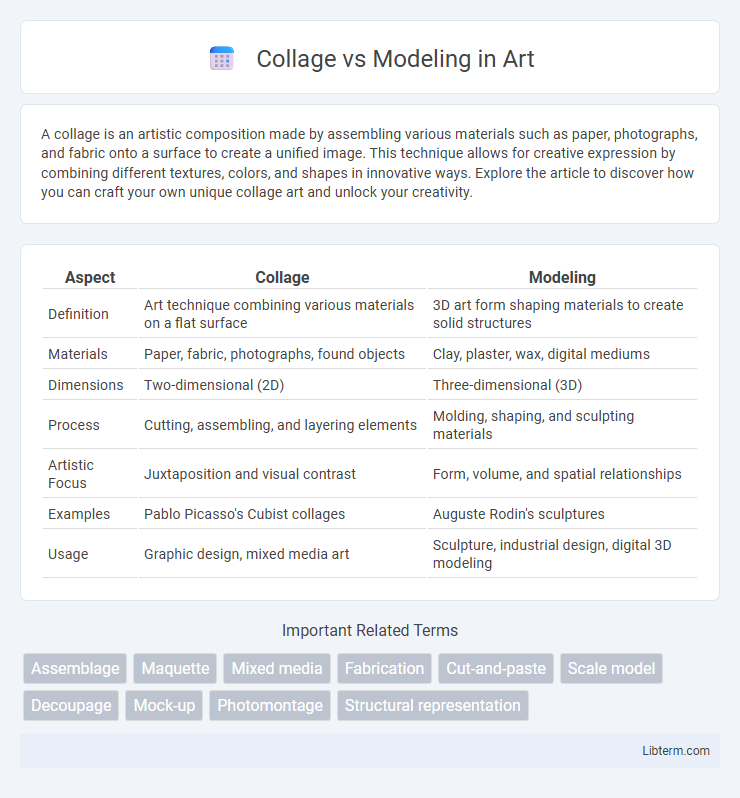A collage is an artistic composition made by assembling various materials such as paper, photographs, and fabric onto a surface to create a unified image. This technique allows for creative expression by combining different textures, colors, and shapes in innovative ways. Explore the article to discover how you can craft your own unique collage art and unlock your creativity.
Table of Comparison
| Aspect | Collage | Modeling |
|---|---|---|
| Definition | Art technique combining various materials on a flat surface | 3D art form shaping materials to create solid structures |
| Materials | Paper, fabric, photographs, found objects | Clay, plaster, wax, digital mediums |
| Dimensions | Two-dimensional (2D) | Three-dimensional (3D) |
| Process | Cutting, assembling, and layering elements | Molding, shaping, and sculpting materials |
| Artistic Focus | Juxtaposition and visual contrast | Form, volume, and spatial relationships |
| Examples | Pablo Picasso's Cubist collages | Auguste Rodin's sculptures |
| Usage | Graphic design, mixed media art | Sculpture, industrial design, digital 3D modeling |
Introduction to Collage and Modeling
Collage is an artistic technique that involves assembling various materials such as paper, fabric, and photographs onto a surface to create a new composition, emphasizing texture and mixed media. Modeling, in contrast, refers to the creation of three-dimensional forms through shaping materials like clay, wax, or digital software, focusing on volume and spatial representation. Both methods serve distinct creative purposes, with collage highlighting surface and juxtaposition, while modeling explores form and structure in sculpture and design.
Definition and Core Concepts
Collage is an artistic technique that involves assembling different forms, such as photographs, paper, and fabric, onto a single surface to create a new, unified composition. Modeling, in contrast, refers to the process of shaping or crafting materials like clay, wax, or digital elements to form three-dimensional representations. Core concepts of collage emphasize juxtaposition, layering, and texture, while modeling focuses on volume, form, and spatial relationships.
Artistic Techniques: Collage vs Modeling
Collage involves assembling various materials such as paper, fabric, and photographs onto a surface to create a layered, textured composition emphasizing juxtaposition and contrast. Modeling, often associated with sculpture and 3D art, focuses on shaping pliable materials like clay or wax to build forms through additive techniques, emphasizing volume and spatial depth. Both techniques explore form and texture but differ in dimensionality and material manipulation, with collage primarily flat and composite, while modeling is sculptural and tactile.
Materials and Tools Used
Collage involves assembling various materials such as paper, fabric, photographs, and found objects, often adhered using glue, scissors, and cutting knives for layering and texture creation. Modeling, particularly in sculpture, relies on tools like modeling knives, wire, armatures, and materials such as clay, wax, plaster, or polymer to shape and form three-dimensional figures. Both processes require distinct materials and specialized tools tailored to their two-dimensional or three-dimensional artistic expressions.
Creative Processes Compared
Collage and modeling both engage distinct creative processes that emphasize material manipulation and spatial awareness. Collage involves layering and reassembling diverse visuals or textures, fostering a tactile exploration of contrast, balance, and narrative through two-dimensional composition. Modeling extends creativity into three-dimensional form by shaping materials like clay or digital polygons, promoting an understanding of volume, structure, and physical presence within space.
Applications in Modern Art
Collage techniques in modern art emphasize layering diverse materials such as paper, photographs, and fabric to create textured, multidimensional compositions that challenge traditional aesthetics. Modeling, often used in sculpture, shapes malleable materials like clay or wax into three-dimensional forms, offering artists a tactile approach to express abstract or realistic concepts. Both methods enrich contemporary art by expanding the possibilities of form and material, influencing movements like Cubism, Surrealism, and Mixed Media art.
Advantages of Collage
Collage offers unparalleled creative freedom by allowing artists to combine diverse materials such as paper, fabric, and photographs, resulting in unique, textured compositions that cannot be replicated through modeling. It enables experimentation with layering and juxtaposition, fostering innovative storytelling and personal expression. The accessibility and affordability of collage materials make it an inclusive medium for artists of all skill levels to explore visual concepts without the need for specialized tools or extensive training.
Benefits of Modeling
Modeling offers significant benefits by providing hands-on experience that fosters creativity and boosts confidence in personal presentation. It enhances communication skills through interactions with photographers, designers, and audiences, creating opportunities for networking in the fashion and entertainment industries. Unlike traditional college education focused on theory, modeling delivers practical exposure and potential financial rewards early in one's career.
Common Challenges and Solutions
Collage and modeling both face common challenges such as maintaining visual coherence, managing material complexity, and achieving desired dimensionality. Effective solutions include careful selection and layering of elements in collage to ensure thematic unity, and the use of digital tools or prototypes in modeling to refine structural accuracy and detail. Leveraging advanced software and iterative design methods enhances precision and creativity, addressing challenges in both artistic and technical processes.
Choosing the Right Approach for Your Art
Choosing between collage and modeling depends on your artistic goals and preferred medium; collage involves assembling diverse materials to create layered, textured visuals, while modeling emphasizes shaping three-dimensional forms using clay or digital tools. Artists seeking intricate surface detail and tactile expression may find modeling more suitable, whereas those interested in mixed-media experimentation and dynamic compositions might prefer collage. Evaluating the intended emotional impact and technical skills required can guide you to the right approach for your art.
Collage Infographic

 libterm.com
libterm.com